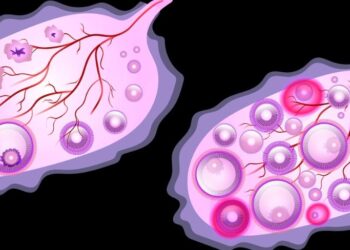Have you observed that most women appear to suffer from hormonal imbalance or PCOS? Women all across the world have recently developed this condition. PCOS has been around for a long time, although its prevalence has increased significantly in recent years.
According to one study, the prevalence of PCOS has increased across the Middle East and North Africa region, which states that “PCOS accounted for 236,312 incident cases in 2019, with an age-standardized rate of 77.2 per 100,000 women, which has increased 33.7% since 1990.”
Polycystic ovary syndrome, or PCOS, is a hormonal condition that affects many women of reproductive age. It is characterized by small fluid-filled sacs in the ovaries known as cysts and increased androgen levels (male hormones), which can cause symptoms such as irregular periods, increased hair growth, acne, weight gain, and problems conceiving. In this article, we will look at the probable reasons why PCOS is growing more widespread.

Possible Reasons for Increased Prevalence
Increased awareness and testing for PCOS:
The WHO states that, “up to 70% of affected women remain undiagnosed worldwide.” Many women with PCOS may not have received a diagnosis in the past because they did not know about the symptoms or did not think they were serious enough to require further testing, according to them or their medical professionals.
However, more women are identifying the symptoms and seeking medical assistance as awareness of PCOS has increased among the general public and healthcare professionals. The claim of higher prevalence is influenced by this proactive strategy to seek diagnosis and treatment as well as improved awareness.
Shift in diagnostic criteria
Over time, the medical community’s understanding of PCOS has evolved, resulting in revisions in diagnostic standards. These adjustments may include widening the criteria for diagnosing PCOS, such as taking into account more symptoms or altering thresholds for specific diagnostic tests.
As a result, more women who did not previously meet the diagnostic criteria are now being diagnosed with PCOS, resulting in an apparent rise in prevalence.
High-glycemic diets
These are diets high in refined carbohydrates and sugars, which are often found in processed foods and sugary snacks. Such diets can cause insulin resistance, in which the body’s cells become less receptive to insulin, a hormone that regulates blood sugar levels. Insulin resistance is significantly linked to the development of PCOS.
Potential link with insulin resistance
Insulin resistance, worsened by poor dietary choices, is thought to have a substantial role in the development of PCOS. When the body becomes insulin resistant, the pancreas generates extra insulin to compensate, resulting in hormonal imbalances that can interrupt ovulation and increase PCOS symptoms.
Obesity connection with insulin resistance
Obesity, defined by excess body fat, is strongly associated with insulin resistance. Adipose tissue, or fat cells, produce hormones and other chemicals that can interfere with insulin activity, consequently contributing to insulin resistance.
Exposure to endocrine-disrupting chemicals (EDCs):
Environmental exposure to endocrine-disrupting chemicals (EDCs) can disrupt the body’s hormonal systems. Examples include plastics, insecticides, and industrial chemicals. EDCs can alter the endocrine system, resulting in hormonal imbalances linked with PCOS.
Challenges in Finding a Cure
PCOS develops as a result of a combination of genetic (inherited features) and environmental factors. It’s difficult to pinpoint a single cause because it’s a combination of several things. Unlike certain diseases, which have only one obvious cause, such as a germ or a single gene defect, PCOS can be caused by a variety of factors.
PCOS manifests differently in every person. Some people may have difficulties with their periods, while others may experience increased pimples or excessive hair development. It’s as if everyone has their own distinct type of PCOS. Because each person’s PCOS is unique, there is no one-size-fits-all cure. What works for one person may not work for another because everyone’s PCOS is unique.
Conclusion
Up to 70% of affected women go undetected worldwide. Unfortunately, there is no cure for PCOS yet. While a definite treatment is still unclear, current research provides optimism for future advances in understanding and treating PCOS. Meanwhile, healthcare providers focus on symptom management through lifestyle changes, drugs, and other interventions customized to each patient’s specific needs.
















